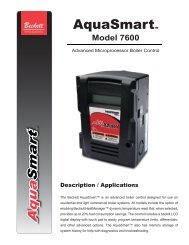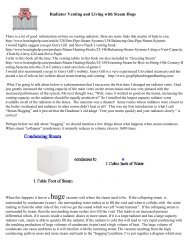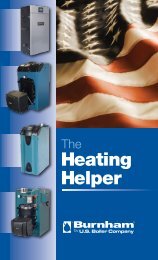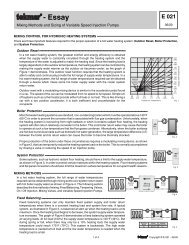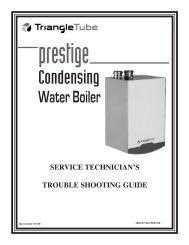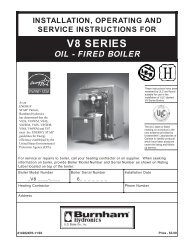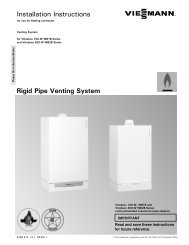Steam Locomotive Firebox Explosion on the Gettysburg Railroad ...
Steam Locomotive Firebox Explosion on the Gettysburg Railroad ...
Steam Locomotive Firebox Explosion on the Gettysburg Railroad ...
Create successful ePaper yourself
Turn your PDF publications into a flip-book with our unique Google optimized e-Paper software.
nozzles. The Advisory Mechanical Committee,<br />
Equipment Engineering Department,<br />
of <strong>the</strong> C&O Railway, <strong>the</strong> Erie <strong>Railroad</strong>, <strong>the</strong><br />
Nickel Plate, and <strong>the</strong> Pere Marquette Railway<br />
issued Standard Maintenance Equipment<br />
Instructi<strong>on</strong>s #105 <strong>on</strong> August 3, 1936,<br />
for boiler washing and blow down. In<br />
November 1995, <strong>the</strong> members of TRAIN, in<br />
an effort to promote safe steam-locomotive<br />
operati<strong>on</strong>, sp<strong>on</strong>sored seminars <strong>on</strong> <strong>the</strong> proper<br />
method of boiler washing.<br />
During his testim<strong>on</strong>y, <strong>the</strong> first fireman<br />
described how he washed <strong>the</strong> boiler of<br />
locomotive 1278 by himself:<br />
You take <strong>the</strong> four plugs out. In <strong>the</strong><br />
boiler under—by <strong>the</strong> firebox, <strong>the</strong>re’s a<br />
plug in <strong>the</strong> right-hand side and <strong>on</strong> <strong>the</strong><br />
left-hand side up fr<strong>on</strong>t, and <strong>the</strong>re’s two<br />
in <strong>the</strong> back, both sides. You take those<br />
out. There’s three plugs al<strong>on</strong>g <strong>the</strong> top<br />
in <strong>the</strong> cab right above <strong>the</strong> firebox<br />
doors. You take <strong>the</strong>m out and <strong>the</strong>n you<br />
wash <strong>the</strong> boiler out. You run—we<br />
have, I believe it’s a 2-inch hose that<br />
we run through it. We wash it to <strong>the</strong><br />
point where we get no sediment out<br />
anymore and <strong>the</strong> water is clear.<br />
The CMO of <strong>the</strong> Strasburg <strong>Railroad</strong> in<br />
Pennsylvania summarized how a steamlocomotive<br />
boiler should be washed out:<br />
Take out all <strong>the</strong> washout plugs, and<br />
essentially that’s any plug in <strong>the</strong> boiler<br />
that allows access into <strong>the</strong> boiler. And<br />
when you do that, <strong>the</strong>n basically we<br />
use a hose to try and get <strong>the</strong> highest<br />
pressure we can. And we go to each<br />
washout hole, and we attempt to wash<br />
all surfaces, <strong>the</strong> interior surfaces of <strong>the</strong><br />
boiler. And that’s more or less difficult<br />
depending up<strong>on</strong> <strong>the</strong> design of <strong>the</strong><br />
locomotives. Our little locomotive has<br />
34 washout plugs <strong>on</strong> it. Our biggest<br />
locomotive has 17. It was just <strong>the</strong> way<br />
<strong>the</strong> locomotive was built according to<br />
<strong>the</strong> railroad specificati<strong>on</strong>s. So you just<br />
wash it as thoroughly as you can and<br />
wash <strong>the</strong> stuff basically from <strong>the</strong> top<br />
down, from <strong>the</strong> fr<strong>on</strong>t [to] back, collect<br />
everything in <strong>the</strong> mud ring, <strong>the</strong>n use<br />
your four corner plugs to wash that<br />
stuff out of <strong>the</strong>re. And you make a<br />
special attempt to rattle your arch<br />
tubes, which is a mechanical cleaning<br />
process.<br />
The CMO was asked whe<strong>the</strong>r he thought<br />
<strong>the</strong> boiler in locomotive 1278 had been<br />
recently washed out. He replied:<br />
It could have been; I d<strong>on</strong>’t know. I<br />
have never seen a locomotive that<br />
blew up before, so I d<strong>on</strong>’t know what<br />
effect that had <strong>on</strong> things. It had a lot of<br />
scale in it. It had a lot more scale than<br />
I would like to see in a boiler if that<br />
boiler was in service at Strasburg.<br />
Low-Water Devices--During <strong>the</strong> investigati<strong>on</strong>,<br />
<strong>the</strong> Safety Board explored <strong>the</strong><br />
availability of devices that can prevent or<br />
warn of low water or mitigate <strong>the</strong> effects of<br />
such a c<strong>on</strong>diti<strong>on</strong>. Research revealed that <strong>the</strong><br />
railroad industry has over <strong>the</strong> years<br />
developed several such devices.<br />
Low–Water Alarms-–<strong>Railroad</strong> industry<br />
manufacturers and suppliers developed a variety<br />
of devices that warned that <strong>the</strong> level of<br />
water in <strong>the</strong> boiler was too low. The devices<br />
warned engine crewmembers before <strong>the</strong><br />
boiler exploded or <strong>the</strong> crownsheet burned.<br />
Low-water alarms were made by <strong>the</strong> Nathan<br />
Manufacturing Company of New York, <strong>the</strong><br />
Ohio Injector Company of Illinois, and <strong>the</strong><br />
Barco Manufacturing Company, Inc. Some<br />
of <strong>the</strong> alarms used floats while o<strong>the</strong>rs detected<br />
abnormal expansi<strong>on</strong> and/or temperature.<br />
Once activated, <strong>the</strong> alarm signaled <strong>the</strong><br />
32



